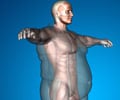New investigations into obesity may identify people with an inherited risk of weight gain, explain why crash diets often fail and address a danger period in childhood that leads to
New investigations into obesity may identify people with an inherited risk of weight gain, explain why crash diets often fail and address a danger period in childhood that leads to obesity in adult life.
Sifting through the genetic codes of 77,000 people, a British-led international team say they have found culprit variants in DNA near a gene already fingered in the molecular ballet that causes obesity.The gene, called MC4R, orchestrates appetite and energy expenditure.
Previous research has already found that MC4R, when flawed, triggers a form of chronic over-eating and weight gain which is rare but dramatic, especially when it strikes young children.
The newly-found variants are more common than the flaws on MC4R, though, according to the paper, published on Sunday in the journal Nature Genetics.
The variants do not lie on the gene but close to it. The theory is that they disrupt the workings of MC4R in some way, although how this happens remains unclear.
People who have the variants in both sets of their chromosomes on average increase in weight of about 1.5 kilos (3.3 pounds) compared to counterparts who had no copies.
Advertisement
People who have double sets of the variants near MC4R and of a flawed gene called FTO are on average 3.8 kilos (8.5 pounds) heavier than people without these characteristics, according to the new study.
Advertisement
Researchers at Sweden's Karolinska Institute found that fat cells, or adipoctyes, increase in number during childhood and adolescence.
By adulthood, the tally is stable, they say. As older fat cells die, they are replaced by new ones. On average, the annual turnover rate among adults is nearly 10 percent of adipocytes, regardless of the person's age or corpulence.
The implications of this are far-reaching, say the scientists.
New-born adipocytes may crave energy in the form of fatty molecules called lipids. As a result, the cells bulk out and the body weight returns.
"The results may, at least in part, explain why it is so difficult to maintain weight after slimming," said Peter Arner, a co-leader of the team.
"The fat cells generated during and after weight reduction need to fill up their lipids rapidly."
Another breakthrough is the determination that the number of adipocytes, for all people, is set during childhood and adolescence and remains largely unchanged, even if one loses weight.
Most obese adults have been obese since childhood. Less than 10 percent of children with normal weight go on to develop adult obesity, according to figures cited in the study.
By contrast, over three-quarters of obese children go on to become obese adults.
According to the team's calculations, among obese people, the moment when adipocytes start to rise is very early, at the age of 2.1 years on average, compared with 5.7 years for lean people.
Once the increase starts, the number of adipocytes multiplies at nearly twice the rate among the obese than among the lean. But, among the obese, the increase stops sooner, at 16.5 years, as opposed to 18.5 years for people who lean.
Two tempting targets thus open up for drug designers, say the authors.
One is a potential treatment that would curb the renewal of adipocytes in adulthood. Another is a putative drug to brake the expansion of fat cells among vulnerable children during the period at risk.
Obesity and obesity-related diseases such as diabetes have gained epidemic proportions in many developed economies.
The causes, though, are complex. Sedentary lifestyle, snacking on fat and sugary foods and genetic inheritance are the most frequently-named sources.
Source-AFP
SRM








